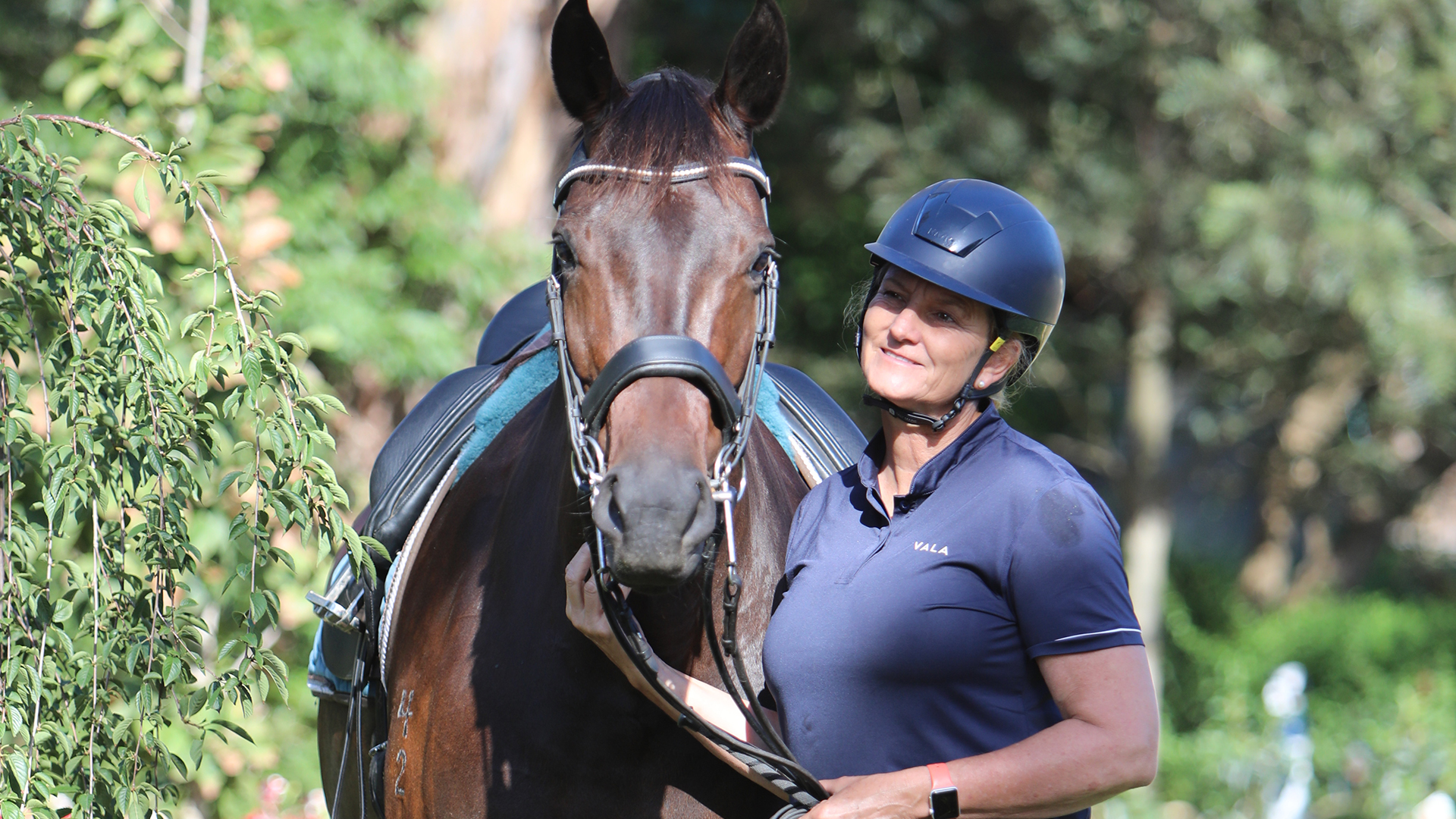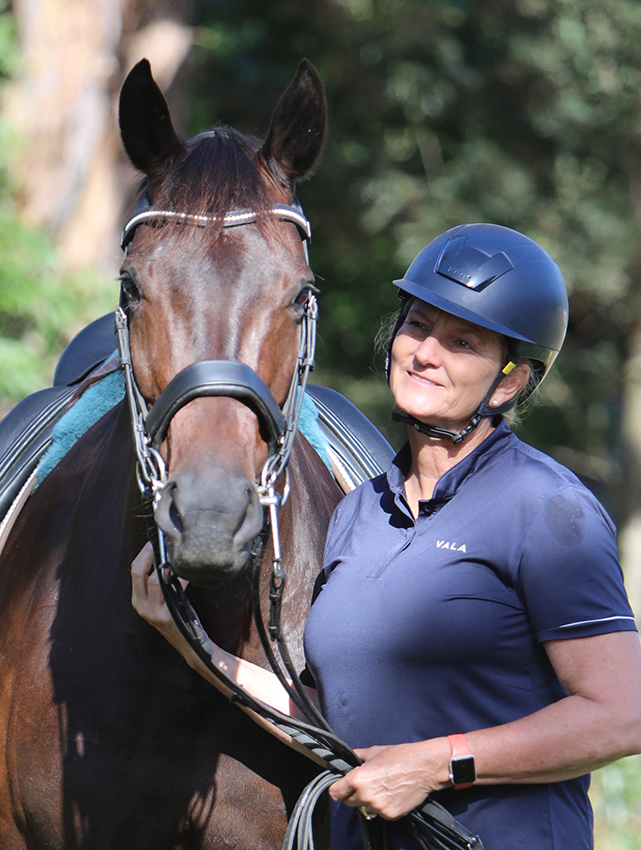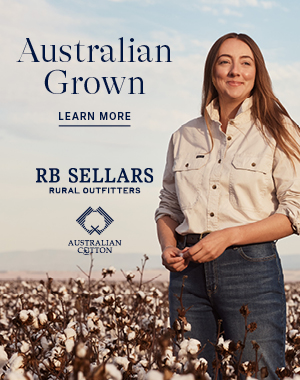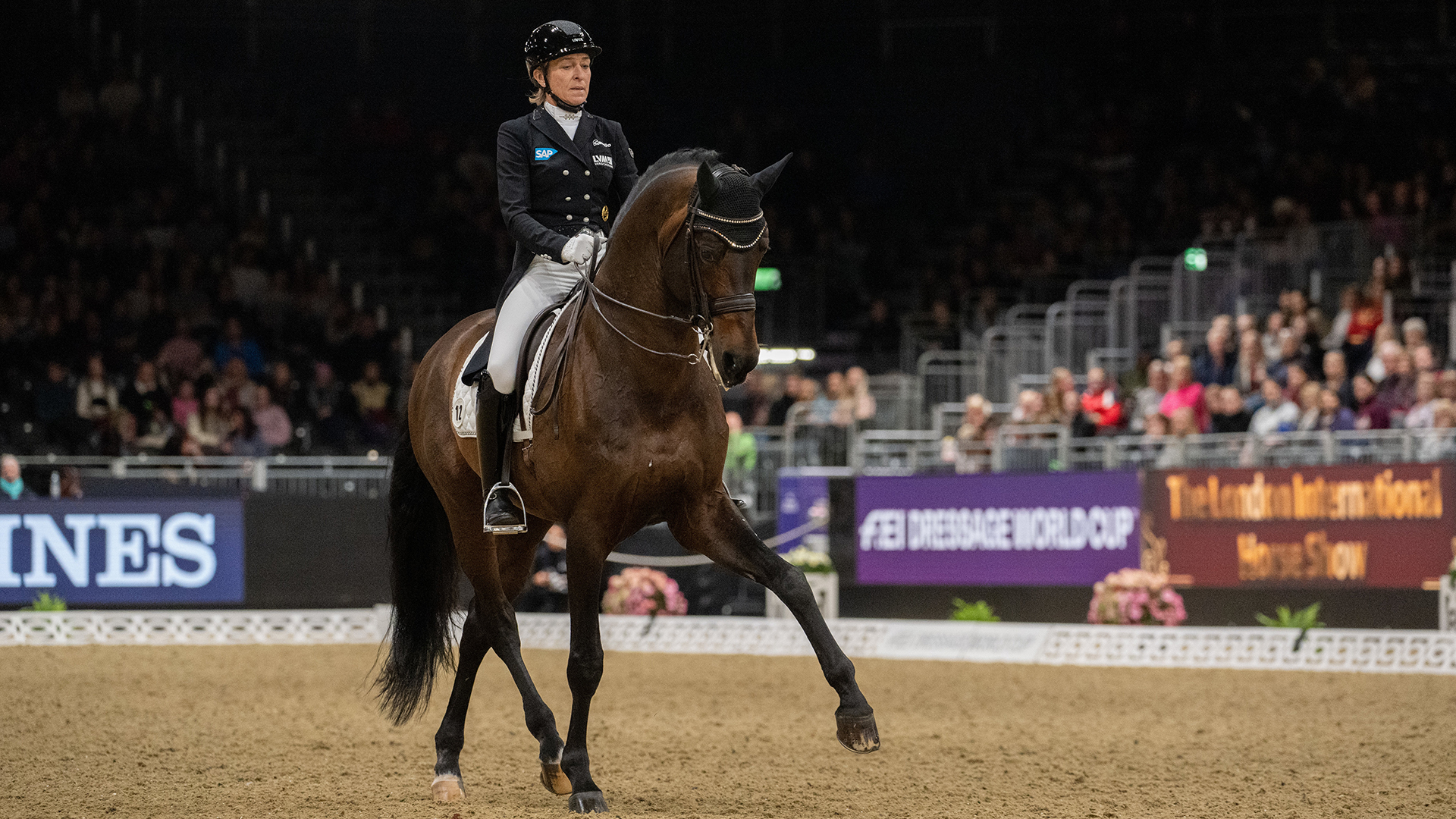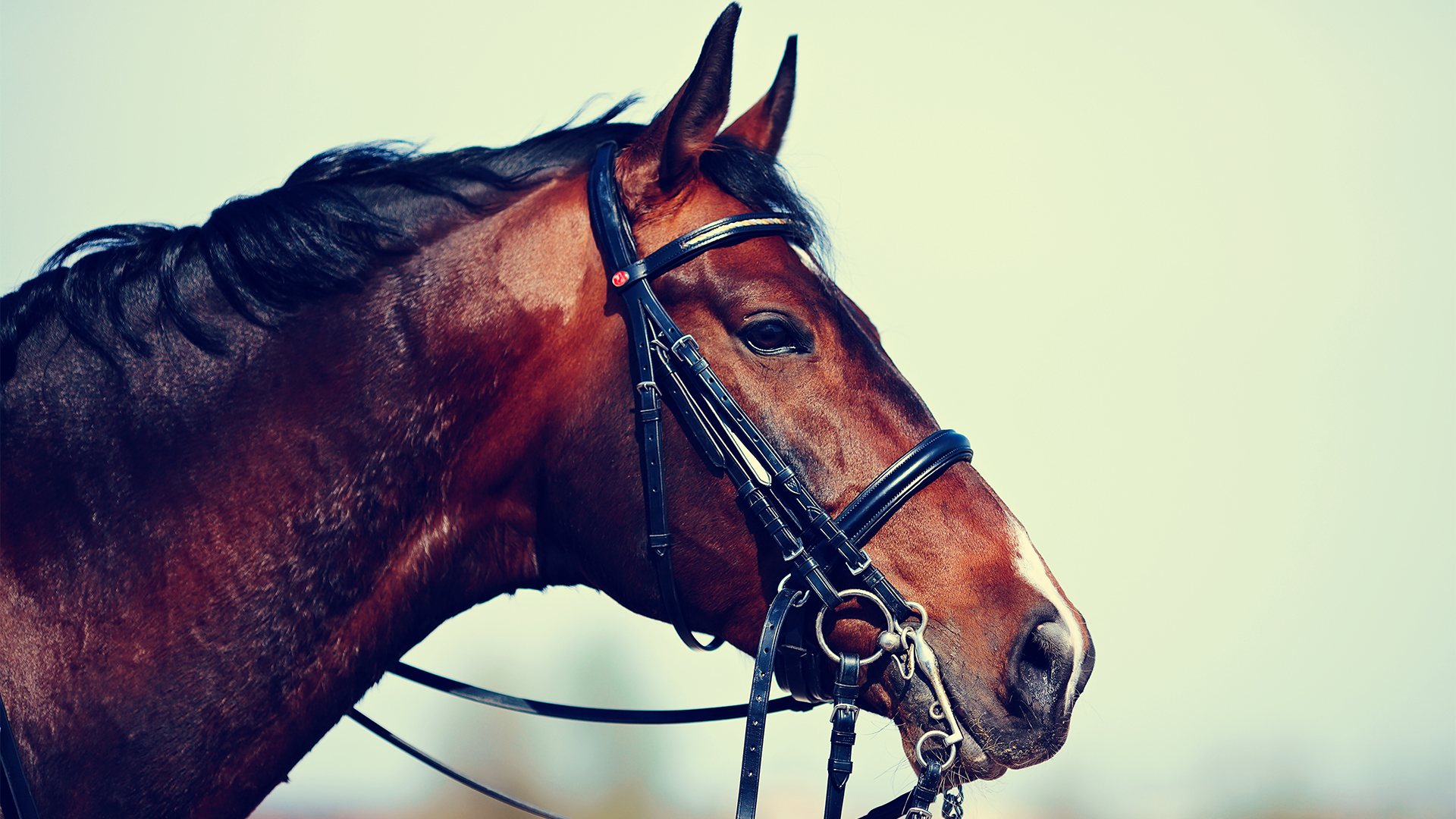Jocelyn West has always combined her love of horses, riding and the pursuit of knowledge with the aim of striving for her best. Now she has channelled all her energies into her ultimate vocation, a specialised horse bit-fitting practice.
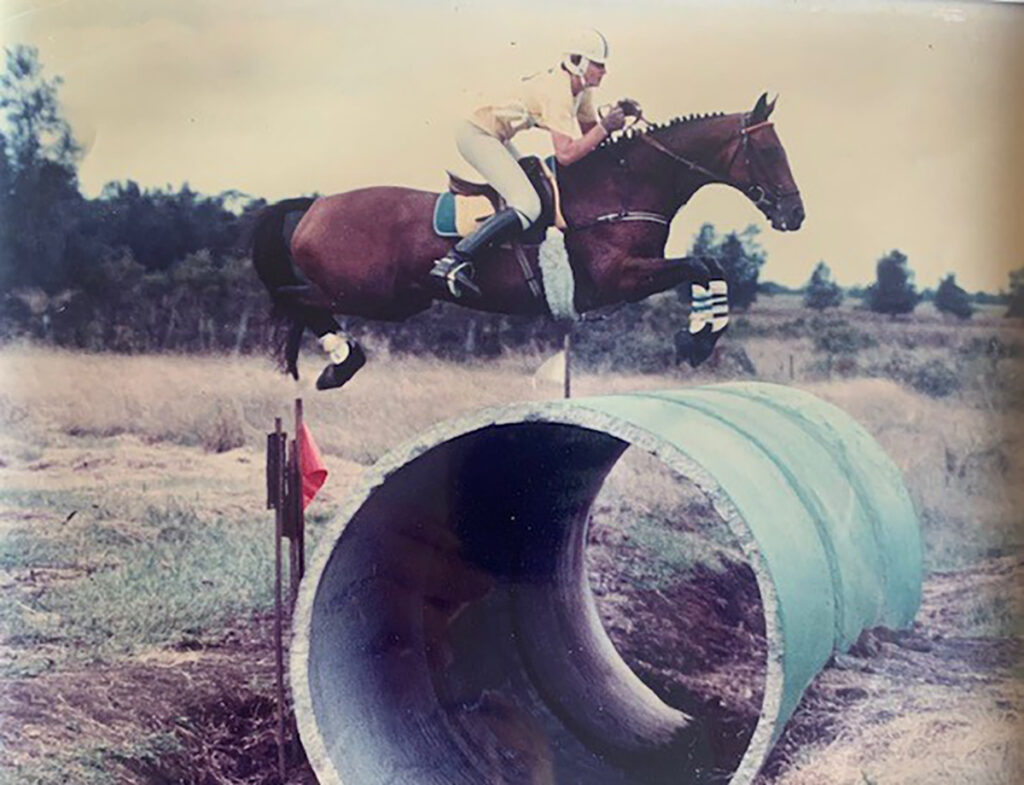
Joc competing with Grand Fashion at Worigee Horses Trials, where she and best friend Kellie-Anne were the only two out of 30 to go clear and not fall off during the cross country phase! Image supplied.
Born in Condobolin, Central West NSW, Jocelyn Greig had a love of horses from a young age. Her mother and father were not particularly horsey, but living on a wheat and sheep farm they thought it would be good for their three girls to have an interest in horses and so a pony was purchased.
They had to start from scratch and the learning curve was fairly steep. Joc’s mother became the secretary of the local Pony Club and they attended club events and rallies. As Joc says, “It was all a little mad at that time and we were just wild country kids who loved riding, galloping, games, and eventing. We didn’t think so much about dressage back then!”
Pony Club gave all three a great start and the competitive and daredevil spirit soon started to erupt, with Joc taking a keen interest in eventing. She was very successful with an Australian Stock Horse show hack that was purchased for her at a bargain price. Staff at Telecom, then the only telephone service providers, were on strike when the horse was advertised in The Land, and as a result no one could call the vendors at Parkes. It was through Greig family contacts that an offer was made and Grand Fashion (“BJ”) was purchased – at a very fair price as the owners were getting no response!
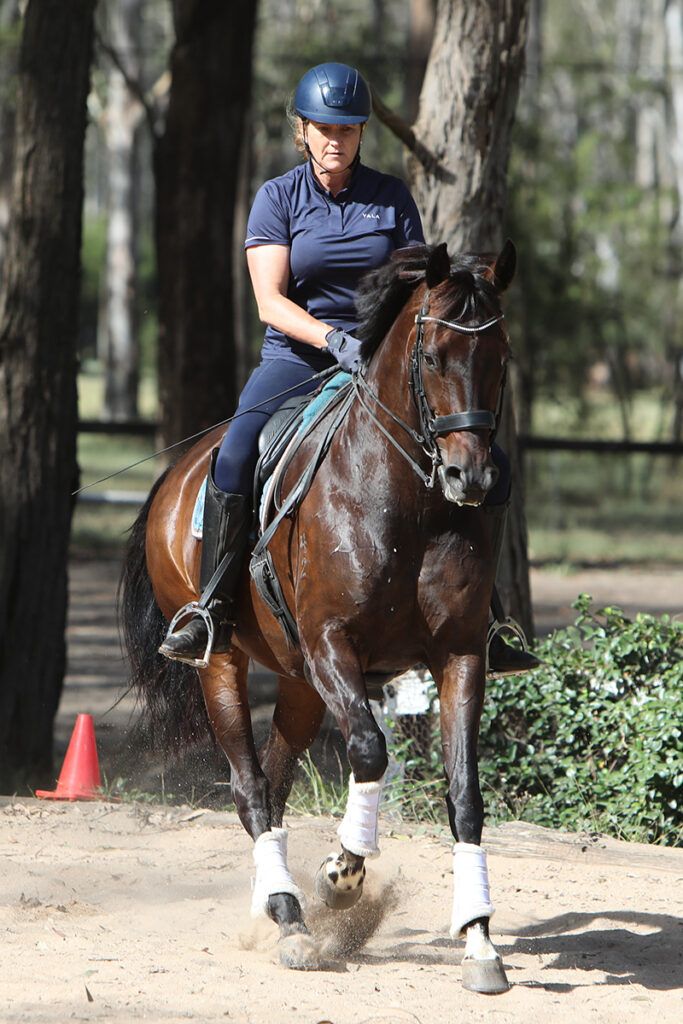
Joc has developed a love of dressage. Image by Roger Fitzhardinge.
“Horses surely need to feel
comfortable with the bit that
is put in their mouth!”
Passionate and keen in everything she takes on and wanting to know the most she could about all the products, she did a saddle-fitting course enabling her to be more knowledgeable when helping the clients.
INTEREST SPARKED
One day, a rep from the notable South African horse bit innovators, Bombers, came by the shop to give a talk and demonstration of their range of bits. Joc, of course, soaked up the knowledge and realised it was an area in competition and training that was underutilised and not well enough understood. This sparked a huge interest in Joc’s mind: saddle fitting, correct fitting gear and clothing were all on her radar, but this realisation that a horse’s mouth comfort was essential became a focus and interest.
Horses surely need to feel comfortable with the bit that is put in their mouth! A horse’s mouth is super-sensitive, and since the reins are the communication apparatus to the rider it’s crucial to feel sure you have done all you can to be certain that the style of bit is the most appropriate to that horse’s mouth; this piece of equipment should be properly researched.
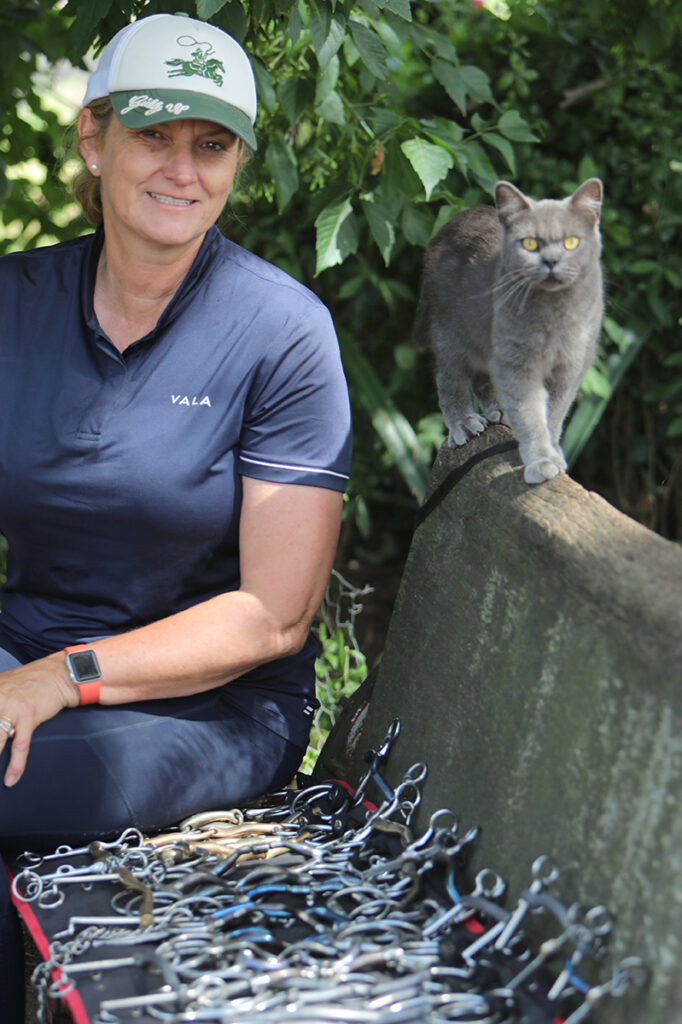
Joc became interested in bit fitting when a rep from Bombers Bits visited Saddleworld Dural to give a talk and demonstration. Image by Roger Fitzhardinge.
Metal, plastic, rubber… smooth, rough, one-jointed or more, thick, thin, straight, curved, ported, forwards or upwards, loose ring, fixed ring, hanging-cheeked, curb action, gag action, mullen mouthed… the list and combinations go on, as endless as the differing needs that horses require.
It was no wonder that Joc was so thirsty for inspiration, knowledge and experience in learning how to improve a horse’s comfort and a rider’s ability to achieve the best contact medium possible with their horse.
“I’d always put it down to just the way horses were and also to the training,” says Joc. “If you trained along the right way, these things would all fix themselves. Bombers certainly put it in my head as to how many different bits there are and how many different ways you can fit a bit to control and encourage a friendly contact through the horse’s sensation within his or her mouth.
“I started to play around a little from bit to bit myself – but sometimes a little knowledge can be dangerous! Even with these raw minor changes I was able to feel major differences in contact and feel with my own horses. I wanted to spread the word but I felt not educated and knowledgeable enough. So, after much research and my own education – and reading up on conformation of the way a horse’s mouth is built and doing a bit-fitting course and a lot of research – I decided that I would very much like to offer my services,” explains Joc. “With the little knowledge I have acquired there was a passion burning in me to make a difference towards helping many riders, especially in dressage, gain a better result through contact and seeing horses comfortable.”
WEALTH OF KNOWLEDGE
On watching Joc working with riders, horses and bitting it is very clear that she has not only a passion for gaining results but also a wealth of knowledge and a good understanding of the requirements riders need and the horse’s welfare, and how to fit a bit to every mouth. She has experience not only in riding but in educating herself and her logical approach towards life, dressage and helping people. She knows about “happy wife, happy life syndrome” and that a horse’s comfort and improvement from a well-designed and adjusted bit can put a smile on any rider’s face, not to mention the mental relaxation that a horse gets from a good bitting.
Joc West is now branching out on her own with a great name for her business – ‘Happy Horses Bit By Bit’! It is true that you need a very clear understanding of horse mouth conformation, the pressure areas that can be affected, and knowing where horses are sensitive or not sensitive when it comes to contact. To see a horse that is fussy in the contact or has mouth problems, there’s no use just changing bits willy-nilly. The most important thing is to ascertain why the horse is not enjoying the feeling of a certain bit. Before you can treat anything, you need to have a diagnosis.
It’s the diagnosis that is so important and Joc seems to just get it! Her feeling, above all, is that the horse’s face and mouth – as in humans – has little flesh and muscle overlaying it and really is bony and has so many nerves close to the surface. This is where a bridle and bit have a massive impact, as opposed to under a saddle that is fleshy and is a less sensitive area. So many riders pay many, many dollars for saddles and saddle-fitting yet seem to pay less attention to the front-end comfort.
Of course, I know from my experience that saddle fit for horse and rider is of great importance for comfort and performance. It is all super important, but the most sensitive area when riding must be attributed to the bit and contact and it’s exciting to see the attention now on mouth comfort and bit design. It excites me.
I ask Joc to explain how she diagnoses a contact issue in regards to the anatomy of each individual horse’s mouth.
“The first thing to do is to have a general look at the horse’s head – shape and size. Is it wide, narrow? Of course, most modern Warmbloods have a smaller head and the mouth is narrow with a shorter smile,” she says. “An older style horse will generally have a larger mouth with fleshy lips. However, sometimes these types can have larger tongues and more shallow palates, so there is less room for the bit to sit.
THE HORSE’S REACTIONS
“This is a generalisation and you need to look and feel inside the mouth and take accurate measurements. It is very important to watch the horse’s reactions as soon as the bit is placed in the mouth and to check the tension that the adjusted bridle puts on the corners of the lips. Is it sitting with too much or too little tension? And is the noseband placed well and not interfering with the bit and the pressures on the corners of the mouth?
“It’s not always the bit fit but also watching the horse’s expressions to the pressures of the bridle, poll pressure and the noseband – and of course the browband that isn’t annoyingly loose and floppy nor tight behind the ears. This could also be attributing to head tilting and so on. It’s important that the bridle, which is the carrier of the bit, isn’t creating pressure and discomfort itself. It’s not always one focus, you need to have a good feeling about the entire picture.”
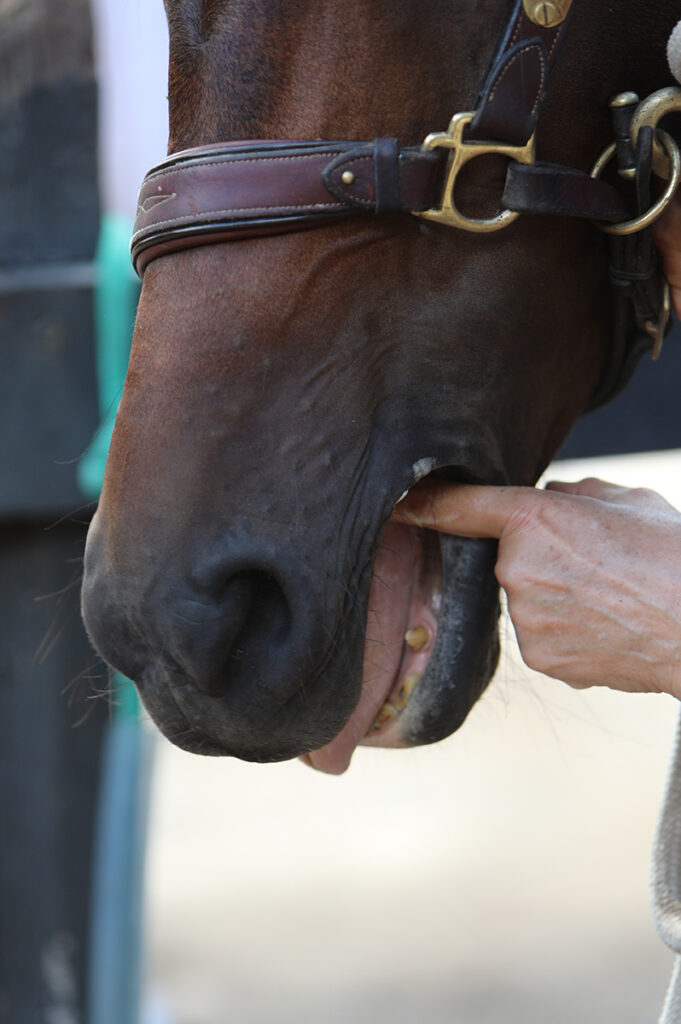
Checking to see the reaction to pressure on the bars. Image by Roger Fitzhardinge.
“I can mostly tell if the bit
is correct the minute the
horse walks off.”
Once you have ascertained the sensitive pressure areas within the horse’s mouth that the horse reacts to, how do you go about knowing which bit to fit?
“I usually ask the rider to begin riding with the bit which they think has worked the best so far and ask them what they feel. In an ideal world, what would they like to change as to the feeling and connection through the rein contact to the mouth? I usually like to begin with a basic single joint and proceed from there.
“If the horse is showing signs of tongue sensitivity, then I’ll try some bits that offer tongue relief. If the bars are more sensitive, then a bit that offers less bar pressure. It really depends on the shape of the horse’s mouth! Horses with a low palate can’t really take a high-ported tongue relief bit. Some bits offer forward tongue relief and this can often provide the comfort the horse requires. It’s trial and error but the horse definitely lets you know very quickly what their preference is.
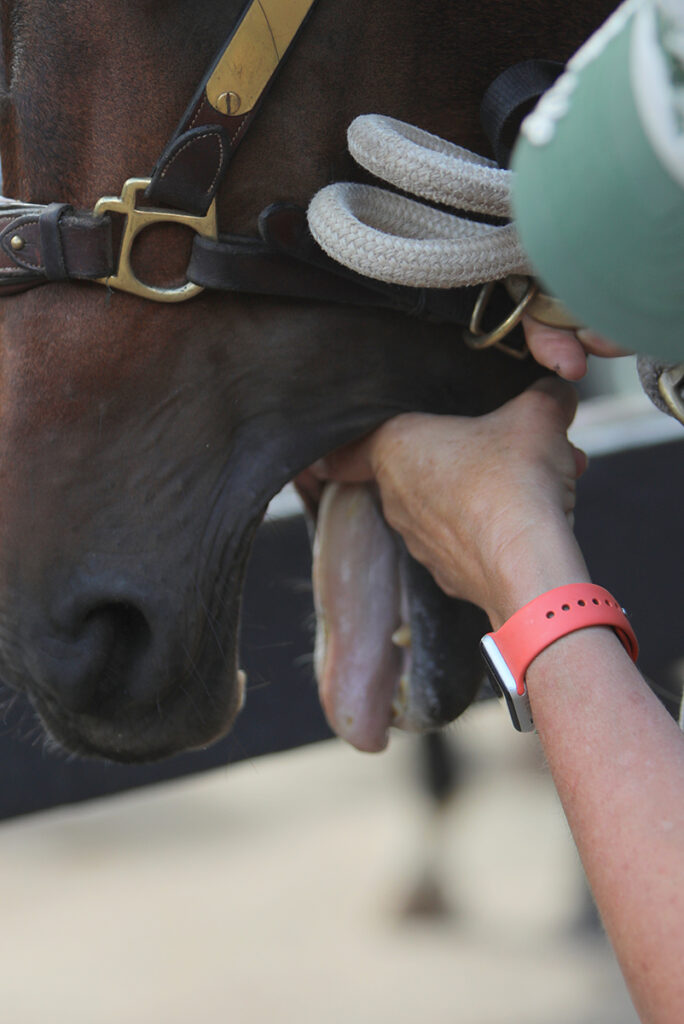
Checking to see reaction to tongue pressure. Image by Roger Fitzhardinge.
“It’s a bit weird… but I can say once I diagnose where the more sensitive areas in a horse’s mouth are, I somehow can relate it as if it was my mouth and what bit would be most comfortable for me if I had the same mouth sensitivity as that horse. Bar-sensitive horses obviously need the pressure removed from the bar’s bony part of the bottom jaw where the bit sits; some horses require both tongue and bar relief.
NO SINGLE BIT FOR LIFE
“It’s about knowing the intricacies of the bits that are available and there are literally thousands. It’s about the bit material. It is really about seeing a horse’s reactions and then refining it down to find the best for that horse at that time of its experience, training and discipline, and the frame and contact required for optimal performance and comfort – and that doesn’t mean that one bit is for life. Feelings and fitness etc change and so awareness to contact can change. With correct bitting a heavy horse may become light and so a softer bit will then be necessary and so on and so on.”
How long do you need to watch a horse in a chosen bit to ascertain whether you are on the correct path to comfort?
“I can mostly tell if the bit is correct the minute the horse walks off. The horse’s frame changes; they become softer in the neck and as a result usually track up better with increased freedom through the neck and shoulders without a bracing effect. The mouth becomes more quiet and the horse feels more elastic in the contact for the rider. The initial result is mostly instant. Of course, some horses have muscle memory that needs time and correct training to make changes, but with the correct fitting bit you have a good foundation to build on.”
If a rider is thinking it’s a bit problem, what other things do you see through the horse’s reactions when moving that could create the resistances in the contact that could be blamed on the bit?
“Contact, of course, is the main issue – too strong, behind the bit, tongue out or over the bit, and generally inconsistent. Other issues indicating you might need a bit fit are: irregular steps through inconsistent contact and intermittent contact; cuts or abrasions to the mouth outside or inside; stiffness or resistance through body; and horses that have a real aversion to being bridled or bitted.
“I don’t want to sound like a jack of all trades, but it is not always the bit. I can only be totally honest with what I see as an FEI rider and a person that has spent years watching and learning through many clinics and seminars as well as watching performance horses compete and be trained nearly every day of my life nationally and internationally.
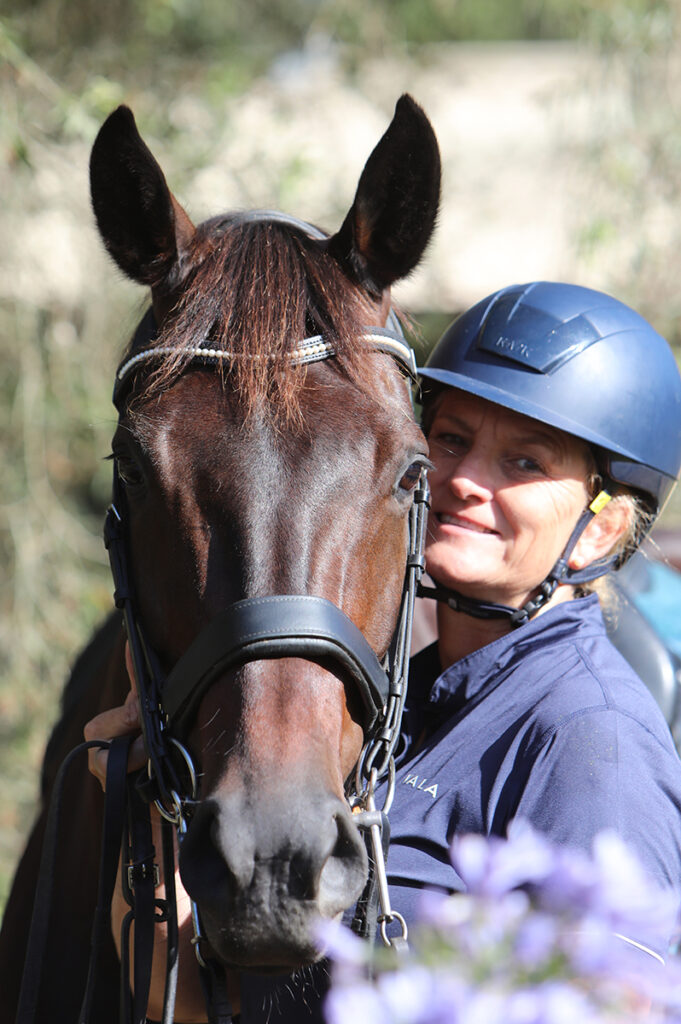
Joc has a burning passion to help riders and owners make sure they can optimise their horses’ ability to perform and be comfortable and more confident. Image by Roger Fitzhardinge.
“A correct bit fit is essential but
it isn’t going to be a fix-it-all!”
“I am still learning something with horses – that never stops. But I do feel I can look at ways horses move, react and resist things as to whether it always stems from the bit. Have you had the teeth checked? Is the horse comfortable in all four limbs? Does he have any residual problems from previous training, injuries or health issues? Does the saddle fit? Is the horse fit and strong enough to carry the rider in the best way? Is the rider sitting in a balanced and easy manner and does the rider have a secure position and good rein control?
“If these boxes aren’t ticked, then even though a good bit is found to suit the horse’s mouth and head conformation, the best result may not live up to expectations and sometimes it’s important to point out other contributing factors to poor and unstable contact. A correct bit fit is essential but it isn’t going to be a fix-it-all!
“It’s always important to ensure the horse is healthy physically and mentally, as this can always create tension and this tension is so often seen in the contact and mouth awareness. Grinding teeth and tail swishing and ears that show attitude are all taken into consideration.
“I love the challenges that I am faced with and to see horses and riders come more together with correct bitting is exciting. The differences I see are simply amazing and I love feeling the help that a good diagnosis of a horse’s needs for bitting can achieve. Not only for the horses but also reassurance for the rider that they feel better about their horse control… comfort and feeling.”
Jocelyn West is an inspiration and a positive and logical horsewoman with a burning passion to help riders and owners make sure they can optimise their horses’ ability to perform and be comfortable and more confident. Quite exciting, inspirational and, above all, encouraging. Happy Horses, Bit By Bit! The perfect scenario! EQ
